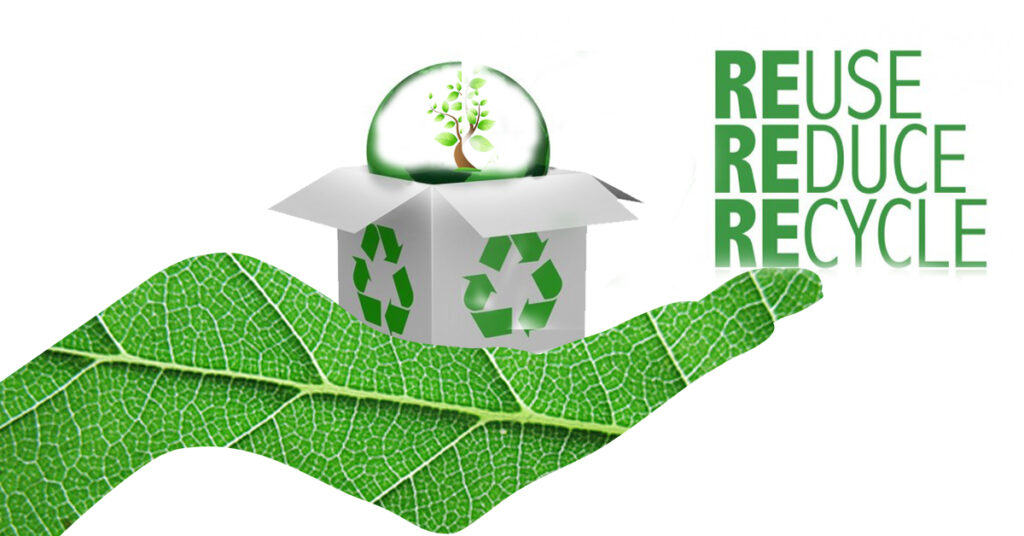Note: The free primer of this detailed report can be requested from here.
Longer shelf life and food quality are some consumer needs today that have led to the development of food packaging technologies in an era where a zero carbon footprint is the need of the hour to ensure a safer place to live in for our generations to come. It is therefore quintessential today to make consumption of natural resources and sustainability, go hand in hand in order to maintain the ecological balance. The way forward for market growth, collaborations, strategies and innovations in the field is majorly to focus on biodegradable, compostable, recyclable, reusable innovations that are earth-friendly and zero waste generators. The sustainable packaging market size is predicted to succeed at around USD 268.2 billion by 2025 and is anticipated to grow at a CAGR of around 6% from 2018 to 2025. This technology analysis report delivers information on sustainable flexible/ wrapping packaging, problem-solution analysis for an array of industries it serves, key players in the sustainable packaging industry, top packaging suppliers, an overview of some key regulatory authorities along with market analysis of the global market trends across various sustainable packaging types.
What sort of sustainable packaging is emerging and what is the current state of innovation?
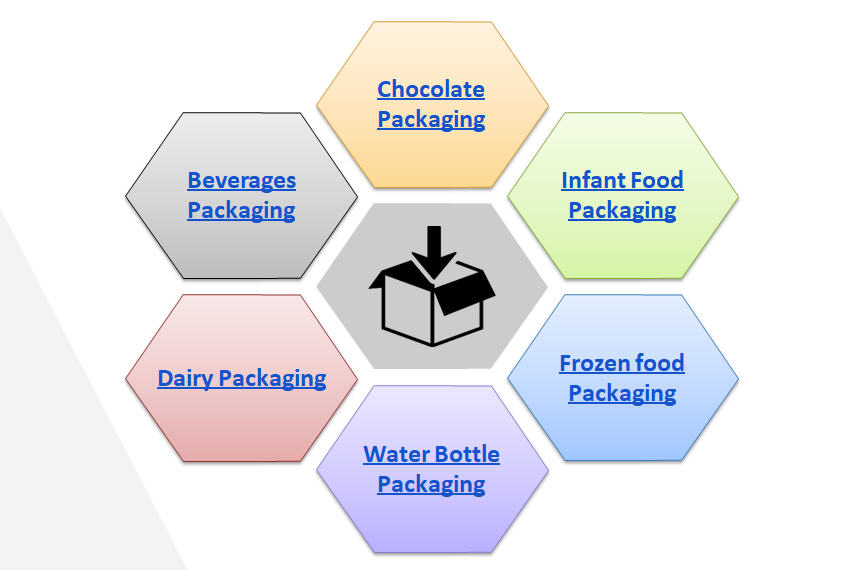
1. Innovation in Sustainable Beverage Packaging
Pressing legislative and consumer needs for transitioning to sustainable packaging materials have led to innovation in the beverage packaging industry. With the technology booming in this sector based on our technology research we found that the development of flexible/ sustainable packaging has come up with innovative coating formulations including recyclable and compostable bottle packaging having compositions like:
- Protein-based paper from whey, potato starch etc.
- Paper board coating systems
- Compostable plant-based wrappers as major emerging areas under innovation.
Startups & key players:
Foxpak a company based in Ireland is a pioneer in digital flexible packaging using recyclable, compostable and repulpable paper options. Eco Bottle is another United Kingdom-based company that uses 100% recycled materials to manufacture eco-friendly refillable drinks containers. Other players in the packaging of beverages through sustainable means include Drift Away coffee (US), Numi Organic tea (US), Elevate packaging (US) etc.
2. Innovation in Sustainable Chocolate Packaging
A lot of chocolate lovers’ frenzy has much to do with the packaging and with this growing industry; innovation in chocolate packaging sustainably is making way for the future. However, a step towards sustainable packaging has presented a challenge to chocolate producers but with revolution in the packaging and wrapping industry, it has also paved newer roads for innovations such as:
- Seed infused packaging that is a plantable packaging with zero waste
- Seaweed-based packaging that promises to keep plastic away from oceans
- Plant-based packaging like mushrooms to eliminate plastic from packaging preventing tones of packaging waste going to landfill.
- Recyclable chocolate bar wrappers with at least 90% paper blank, have a grease proof lacquer layer on both sides.

Startups & key players:
Alter Eco Foods, a United States based company, has made its mark in compostable packaging and ensures that its cacao partners replant the rain forests where the beans are grown. Seed and bean, Northampton, is a chocolate manufacturer making chocolates with organic ingredients besides ensuring that the packaging is environment friendly as well. This company uses flexible cellulose film processed from eucalyptus wood pulp for its packaging.
3. Innovation in Sustainable Infant Food Packaging
Baby food packaging has travelled a long way from bottle jars to cardboard boxes and now have entered a new area of reusable and eco-friendly squeezable pouch packaging wherein these are made up of multiple layers of low carbon content material with combinations of paperboard, recyclable PET and aluminum, keeping the food inside safe from light, air and maintains the freshness of the food. Leak proof zipper seals made from BPA free material leave lower carbon footprints and have found attention in the packaging of infant food.
To gel in with an environment friendly lifestyle, packaging industries have made the packaging tailor made to be adaptably used by parents for feeding their toddlers.
Startups & key players:
Wipak is a Finnish company uses green PE sealing layer and water based ink to label their baby food products. Love Child Organics is a Canada based startup which uses guaranteed BPA free for packaging organic infant food. Another Canadian company Healthy Planet Solutions packages baby food in reusable pouches. Other companies engaged in this field are Piccolo, UK and more.
4. Innovation in Sustainable Frozen Food Packaging
Multi-layered packaging that is used in the frozen food packaging often ends up in landfills as it is partially recyclable or not recyclable at all. With the newly engineered technology standup pouches and recyclable barrier, paper has entered the frozen food packaging industry; alternative biodegradable materials for food packaging and PLA base packaging have found major attention among numerous others in materials for sustainable frozen food packaging.
5. Innovation in Sustainable Water Bottle Packaging
Factors pertaining to increased living standards, portability and ease of access have led to mushrooming in the bottling of drinkable water. PET remains the most used material for packaging, however, the carbon footprint left behind is considerable. This has pushed innovation in the sector towards sustainable packaging of bottled water. Polyethylene made bottles that are easily recycled and reused areas include paper water bottles, paper-PCR water bottles, resealable water bottles which are some of evolving technologies for packaging drinkable water.
Startups & key suppliers:
Boxed Water, a USA based startup, defined a novel category of packaging water in cartons made using paper from sustainably managed forests. Paper Water Bottle an American makes 100% recyclable, 65% compostable; and 98% landfill biodegradable paper water bottles to achieve their ultimate aim of 100% backyard compostability. Another startup trying to do its part for sustainable packaging is the Austrian company CanO water. It makes bottled water in aluminum cans that are infinitely recyclable, the travel time from recycling bins to store shelves being 60 days and staying cold for relatively longer times keeping the water cool and fresh.
6. Innovation in Sustainable Dairy Packaging
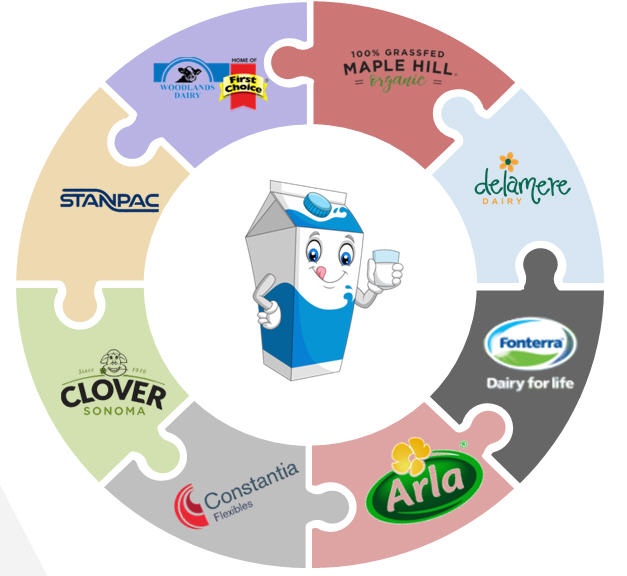
A vast expanse of this industry is shifting to sustainable packaging as dairy products rank as one of the most bought FMCG products globally. Specifically the butter packaging, yogurt packaging, milk packaging and cheese packaging industries have gotten much attention for leveraging sustainable packaging. Bio-based closures, packaging from recycled material, refillable and recyclable glass packaging as major key players of industries such as Ecolam Plus are some technologies to look out for in packaging of dairy products.
Startups & key suppliers:
Stanpac is an established American company that supplies sustainable packaging to companies over the US and Canada. Maple Hills, based in the United States uses the packaging of dairy products from renewable material. Woodlands Dairy is a South African company making bio-based closures for dairy packaging, making them 100% recyclable.
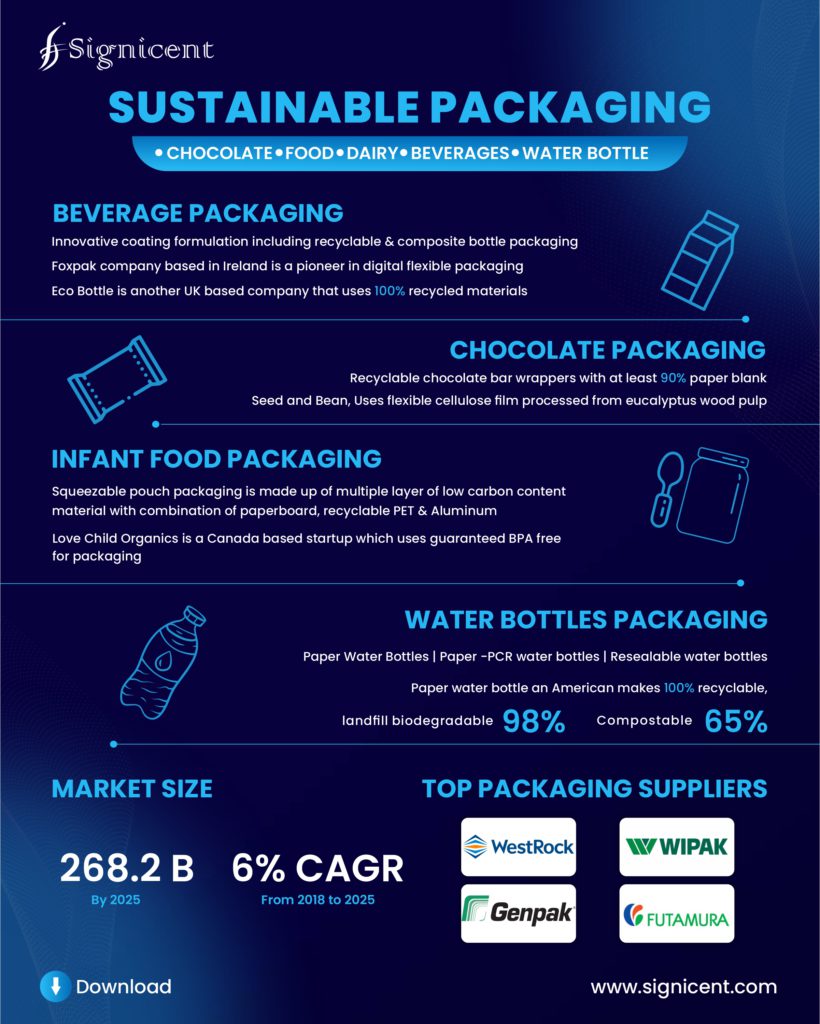
Future innovations
With the world growing increasingly digital, smart packaging has come to the fore and is evolving rapidly. Some technologies to watch out for in the near future:
- Manufacturing using liquid based products, technology has been developed to help foods remain fresh for an extended period of time after heat sterilization such as boiling or retort.
- Thermo chromic ink: can be applied to the packaging that discolors or changes into a particular symbol when the product is brought from room temperature to refrigerator temperature.
- Internet packaging: for tracing the package location from when it is opened to reused can be traced.
- Antimicrobial packaging: slows down oxidation, moisture change and microbial growth, improving food safety and increasing the shelf – life of the package food products.
Top Packaging suppliers
Eco-Products is a company that provides sustainable foodservice packaging products including hot and cold cups, paper food containers, utensils, stir sticks, and renewable, compostable straws, liners and bags. Tetra pack has become a household name in the carton packaging of goods using innovative designs. Lickalix is a Frozen Food brand in Europe that has been awarded the plastic-free trust mark by the environmental campaign group. It is making plant-based packaging 100% compostable, preventing the release of harmful substances into the environment. There are various other key suppliers that work as green packaging suppliers all over the world.
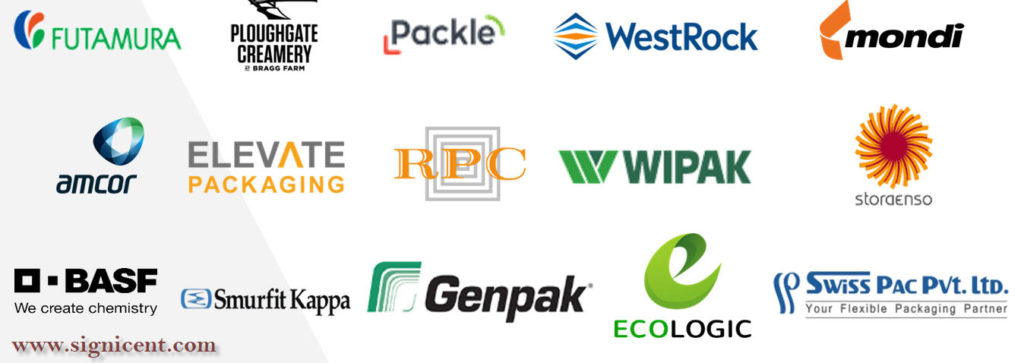
Regulatory Authorities
The main motto of various regulatory authorities such as FDA, Europen, WPO, FSSAI, Commission European food safety authorities is to keep check on the companies in order to make sure the product and services that are delivered must meet with the quality compliance along with promoting globally the technology, science and engineering that has evolved in areas of packaging , skills and expertise required in packaging knowledge, advises on the making more operational units for the purpose to encourage development of international trading along with adopting sustainable packaging methods. A cognizance of product packaging materials regulations is therefore essential for all importers and exporters selling in the European Union or Worldwide.
Market Analysis
Accelerated by a transition from cheaper plastic materials towards recyclable, environment-friendly materials for packaging of various types, the sustainable packaging industry has seen evident expansion. The global sustainable packaging market stood at about $168.3 billion in 2017 and is expected to grow to an estimated value of $268.2 billion by 2025 with a Compound Annual Growth Rate (CAGR) of 6% in this period. Amongst the various sectors that the packaging industry serves, the food and beverage segment has emerged as the largest end-user of sustainable plastic packaging. Geographically, the Asia Pacific region is speculated to be the leader in the sustainable packaging industry.
With growing consumer awareness and stricter government norms, edible packaging materials made from natural ingredients are anticipated to gain popularity in the coming years. The green packaging market registered a value of USD 237.74 billion in 2019 and is expected to be 313.93 billion in 2025 to register a CAGR of 5.7% over the forecast period 2020-2025. The global market size of flexible plastic packaging was valued at USD 97.97 billion in 2016, and is projected to reach USD 131.65 billion by 2022, at a CAGR of 5.2%. The base year considered for the study is 2016 with the market size projected from 2017 to 2022.
Research Methodology
Our team of experts searches for relevant data and performs critical analysis while delivering reports to clients all over the world belonging to numerous technological backgrounds. We use commercial databases for searching of IP literature for searches such as competitive analysis, white space analysis, technology analysis etc.; perform rigorous searches on non patent literature; use various databases for market research and provide further consultation for commercialization options such as technology scouting, licensing, technology transfer, potential buyers, contract manufacturing etc.
Recent Reports
- Transparent Solar Panels Powering Smart and Green Cities
- Future of Cooking with Nanotechnology: How Smart Kitchen Technology Is Transforming Modern Kitchens
- The Hidden Genius Behind Your Devices – Gurtej Singh Sandhu’s Innovations That Fuel Our Digital World
- Hydrogen Fuel Cells — Powering a Cleaner Future of Energy & Mobility
- Antibacterial & Antiviral Technologies for Personal and Home Care


